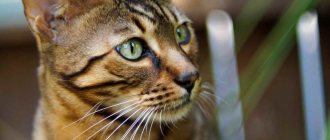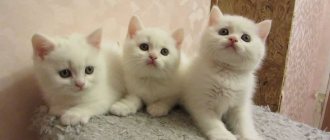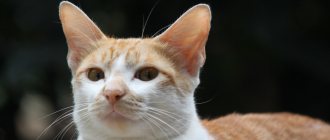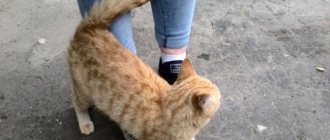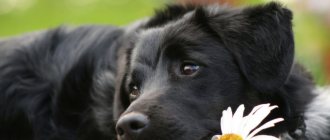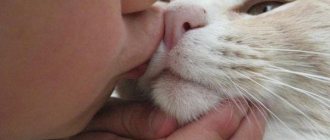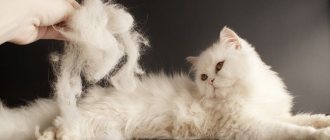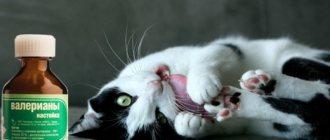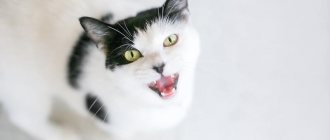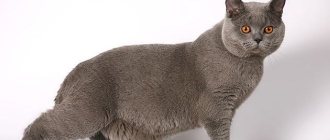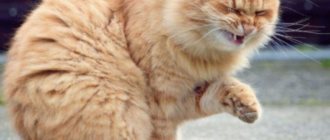A cat with squint is not uncommon, especially among certain breeds. Many owners even like this feature, but how much does this pathology affect the well-being and quality of life of the animal? The disease has several stages of development; in the initial stages it is quite difficult to identify deviations. However, if you suspect that your cat is cross-eyed, you should take her to the vet. If the pathology is congenital, then it will not affect the quality of life of the animal, but if strabismus has developed as a result of injuries or other diseases, the situation should not be left to chance under any circumstances.
Are all Siamese and Thai cats cross-eyed?
Siamese and Thai breeds are prone to this unusual symptom due to the presence of the acromelanism gene in the body. Thanks to him, the animal has an unusually beautiful outfit called color point. It is characterized by the presence of dark-colored limbs and a cream-colored body; the eyes have a rich sky blue color.
Smiling cross-eyed Siamese cat
However, not everything is so wonderful. This gene is also associated with improper development of the optic nerve, which causes the pet to see double images. Advanced forms of pathology can be aggravated by the development of nystagmus - frequent oscillatory movements of the pupil that occur in order to piece together a split picture.
Of course, not all representatives of these breeds suffer from strabismus. The presence of acromellanic coloration is undoubtedly considered a risk factor. A similar pathology can also be detected in Straights, Scottish Folds, Sphynxes and other breeds. The disease can also develop when breeds are crossed incorrectly.
Note! Albino cats are prone to developing strabismus and nystagmus.
History of the origin of the Tonkinese
The appearance of the first Tonkinese and the origin of the name of the breed are attributed to the period “a long time ago.” Even in the ancient Siamese (Siam is the early name of Thailand) “Book of Poems about a Cat”, there is a description of a cat that almost exactly corresponds to the standard of modern Tonkinesis. The name of the breed is associated with the Tonkin region - so in the 16th - 20th centuries. were the territories located in the north of modern Vietnam.
The “official” history of the Tonkinese breed begins in the 30s of the 20th century, simultaneously with the Burmese. Moreover, both breeds have a common ancestor (or rather, ancestor) - the Wong Mau cat, imported to the USA from the East, from which modern American Burmese trace their ancestry.
To improve the breed type, Burmese breeders introduced Siamese cats into the breeding program. Some of the descendants were completely different from their parents. The kittens had an elegant, but not thinned physique, a beautiful unique color and a unique bluish-turquoise, “sea” eye color. Enthusiastic breeders began to develop a new breed, but felinologists did not see any prospects in these breeding programs, and here’s why.
Many external signs of a Tonkinese cat appear if the kitten receives different genes from mom and dad. For example, for the Tonkinese color to appear, one gene must be “Siamese” - it is characterized by a sharp contrast between the body and points (legs, muzzle, ears and tail), and the other gene must be “Burmese” - in this case, the difference between the body and the points are barely noticeable.
According to the laws of genetics, only half of Tonkinese kittens are born with the appropriate breed characteristics. These animals were considered by most felinologists and breeders as a “marriage”, the offspring of unknown reasons mated Burmese and Siamese.
One quarter of the kittens - those who received two “Siamese” genes from their parents, had a Siamese color, another 25% - two “Burmese” genes and a Burmese color. However, such kittens also could not be considered either Burmese or Siamese.
The success and recognition of the Tonkinese cat owes much to the American Jane Barletta and the Canadian breeder Margaret Conroy, who worked on the breed type in the 60s. The breed received its first recognition in the early 70s in Canada. TICA, one of the most respected feline associations in the United States, allowed representatives of the breed to participate in championships in 1979. The CFA, the oldest authoritative felinological association in the United States, recognized the Tonkinese only in 1984, after seven unsuccessful attempts at registration by breeders. Now the Tonkinese breed is recognized throughout the world.
Cat breeds prone to strabismus
A dog whose eyes fall out: a review of breeds
There are breeds of cross-eyed cats that are more likely to develop this pathology. It may appear, or it may bypass the pet. A characteristic feature of these breeds is that they all have an acromelanic color. These include Neva Masquerade, Siamese and Thai cats. Also, the risk group includes completely outbred representatives of the species with a color point color.
Important! Pedigree animals with strabismus cannot perform at exhibitions, since this is a fairly significant reason for disqualification. This should be taken into account by people who want to purchase a purebred animal and perform with it at exhibitions, as well as breed it for sale.
Thai cat with squint
Breeds with slanted eyes - Javanese and Snow Show
The second name is longhaired oriental. She has a wedge-shaped head, a thin muzzle, and wide ears with pointed tips. White cats and colorpoint cats have blue eyes, the rest have emerald green eyes. Very attached to the owner, the voice is soft, the purring is gentle and quiet.
Surprisingly, the character of an animal can be determined by its color. For example, Torty Points are very energetic, active and restless. Red point and cream point are affectionate, gentle and calm. The Lynx Point color characterizes a majestic, graceful cat with a royal stature.
The Snow Show breed is the result of crossing a Siamese and a two-color American shorthair. The name translates as “snow shoe” because of the distinct white toes on the cat’s paws. The color is expressed in two variants - blue and seal point. Shoes must be pure white. The coat is elastic, shiny, and does not require special care. The eyes are blue, set at an angle to the nose. An adult cat with slanted eyes of the Snow Show breed has a calm, patient character and gets along well with children. Loves to swim and plays with water.
Provoking factors of development
Feline strabismus is medically called strabismus. Pathology can be either congenital or acquired. In the latter case, the defect develops against the background of injuries - severe blows to the head or due to falls. Also, a kitten can become cross-eyed after certain diseases:
- developmental pathologies or disturbances in the functioning of the vestibular apparatus (disorientation);
- encephalitis is a viral pathology accompanied by inflammation of brain tissue;
- dysfunction of the central nervous system organs;
- hydrocephalus or dropsy - a disease accompanied by the accumulation of cerebrospinal fluid in the head;
- rabies;
- meningitis - inflammation in the mucous membranes of the brain or spinal cord;
- otitis of the middle or inner ear;
- glaucoma – sudden changes in pressure inside the eye;
- The feline leukemia virus is a disease whose symptoms are very similar to cancer.
Small decorative breed rabbits: review
Strabismus sometimes appears due to a hereditary predisposition. If the genetic eye disease is mild, then there is no need for treatment. Oblique cats quickly adapt and are able to lead a full life.
Important! A purebred cross-eyed cat should not be allowed to be bred in the future.
After injury, due to physical impact, the eyeball deviates from its usual, correct position. Diseases that affect muscle tissue can also provoke strabismus. The cause of the shift may be the development of a neoplasm inside the orbit or the occurrence of inflammatory processes.
Problems in the functioning of the vestibular apparatus lead to the fact that the eyeballs can change their location. The fact is that thanks to the vestibular system, a cat can navigate in space. If something doesn’t work correctly, the brain is not able to correctly perceive information about the position of the head, which, in fact, becomes the cause of strabismus.
Clinical picture of rabies in cats
The development of strabismus can also be provoked by a disturbance in the interaction of the organs of the nervous system (CNS) with the organs of vision.
Note! The occurrence of malignant processes in the brain quite often provokes the development of strabismus.
Treatment of strabismus
Depending on the causes and conditions for the development of strabismus in a cat, treatment can be conservative or surgical. In some cases, no treatment is required at all. With congenital strabismus of a Siamese or Oriental cat, due to the predisposition of the breed, the animal’s body gets used to this condition, the nervous system adapts to the perception of the surrounding world through squinting eyes. In such a situation, strabismus can be considered a cosmetic defect, and intervention is not required.
For acquired strabismus caused by a disorder of the vestibular apparatus, injury, tumor or other disease, it is important to determine its cause, since in most cases the treatment of strabismus will be limited to the treatment of its root cause. For an accurate diagnosis, in addition to a visual examination, additional studies may be needed, in particular, MRI of the eye orbits and MRI of the brain
For strabismus caused by inflammatory diseases, long-term medical treatment with anti-inflammatory drugs will be necessary, which should only be prescribed by a specialist. If the outcome is favorable, strabismus will be completely eliminated at the end of treatment.
In case of strabismus resulting from a neoplasm of the eye orbit or some other neoplasm, the solution to the problem is possible only through surgical intervention. The operation, as a rule, can have a favorable outcome only at the initial stage of the disease. Surgery may also be necessary for injuries that damage the muscles associated with the eyeball. Treatment of strabismus in cats will only be effective if you consult a specialist in a timely manner.
Heterotropic disorder is common in animals
Our beloved pets often develop diseases that affect people. Strabismus in cats is not very common. Each case of such a disease is individual. Below we will look at the reasons that cause this disease, what breeds of cats are susceptible to it, types of strabismus, as well as methods of treating it.
Strabismus is also called strabismus or heterotropia. This is a deviation from the normal position of the eyeball, as a result of which the ocular axes do not coincide.
Cats see a split image. This manifestation affects the cat’s quality of life and causes a lot of inconvenience for the pet. However, over time, the animal gets used to living with the disease and practically does not feel it.
Clinical picture and types of strabismus
The acquired disease in animals can develop unilaterally or bilaterally. In the first option, only one eye changes its anatomically correct position, in the second case, respectively, two. Both eyes move in their orbits; several small muscles are responsible for this function. Strabismus occurs when the functioning of these muscle tissues is disrupted and the eyeball is displaced.
Molossians (dogs): breed varieties and overview
In the vast majority of cases, deviations can be detected visually. A clear sign of strabismus is evidenced by asymmetrically located corneas and pupils.
Note! If an animal fixes its gaze on a certain object, but its eyes are fixed differently, then this indicates the presence of pathology.
Representatives of Siamese and Oriental breeds often have pupils close to the nose. This form of pathology is called convergent. If, on the contrary, the pupils are distant from the nose, then this form of the disease is called divergent. The first form is the most common and is often congenital.
Unilateral strabismus in cats
Appearance
Georgian cats are elegant, graceful animals, endowed with a special “oriental” charm. Males are slightly larger than females, the former weigh 6–8 kg, the latter – about 5 kg.
A description of the appearance of a Georgian cat according to the breed standard is given in the table.
| head | small, narrow, elongated, triangular in shape (an equilateral figure is formed by connecting the ends of the ears and chin) |
| eyes | large, almond-shaped, set close to each other, iris color varies, determined by color, but most often green, white individuals have blue eyes |
| ears | large with a wide base and sharp tips, widely spaced |
| nose | long, with a large lobe, the angle between the nose and forehead is not pronounced |
| torso | long, lean, sinewy, developed muscle mass, lean, thin skeleton, tucked belly, narrow but voluminous chest, often protruding in a keel-like manner |
| limbs | long, slender, strong, the hind legs are slightly longer than the front ones, the paws are small, oval |
| tail | long, thin, whip-like |
| wool | short, no undercoat, guard hairs silky, shiny |
There are a huge number of colors of oriental cats; more than three hundred are known. Basic options:
- chocolate;
- lavender (silver-gray with a pink tint);
- blue;
- cinnamon (light brown);
- faun (beige);
- red;
- black;
- white;
- tabby – patterned (stripes, spots, marble);
- ticked (each hair is divided into two parts according to color).
Is correction required?
Does a cat with slanted eyes need correction? From birth, an oblique cat does not need treatment, this is due to the fact that hereditary strabismus is only an external defect that does not in any way affect the health and condition of the pet.
If the pathology is acquired in adulthood, then your shaggy friend should be taken to a veterinary clinic as soon as possible. To make an accurate diagnosis, in most cases, veterinarians prescribe an MRI to study the eye orbits and brain, as well as to identify abnormalities in the functioning of the vestibular apparatus and nervous system.
When inflammatory pathologies are detected, the doctor prescribes complex drug treatment. With a well-designed therapeutic course and strict adherence to all the doctor’s recommendations, strabismus in an animal can be completely cured.
Convergent strabismus in cats
If a cat's gaze has become crooked as a result of a fall, blows, or damage to the eye muscles, then only one treatment method will be effective - surgery. The outcome of the operation will be positive only if the disease was detected at the initial stages of its development. That is why it is extremely important that the owner, when identifying the first deviations, immediately shows the pet to the doctor.
Medical observations show that an eye that is deviated to the side can see worse and worse over time until its visual functions are completely lost. Depending on the provoking factor, the animal’s vision may disappear completely. Early diagnosis of pathology will prevent the development of irreversible structural changes in eye tissue.
If, as a result of the disease, only the eye muscles were affected, surgery can be performed under general anesthesia to return the tissues to the correct anatomical position. During the operation, the tension of the affected muscle tissue must be taken into account. Treatment will be aimed at weakening or, conversely, strengthening the muscles that displace the eyeball.
Today on the Internet you can see many cute and funny photos of cross-eyed cats with a smile. It's great that people find birth defects cute, love their pets even more, and give them funny names. However, to prevent the animal’s condition from worsening, it must be shown to a veterinarian at regular intervals. Lack of treatment if necessary can cause complete loss of vision.
Abyssinian
It has not yet been established exactly where the Abyssinian cat came from. There are many versions and guesses, but one thing is certain - the animals belong to the first domesticated cats.
Abyssinians look very graceful and elegant, it seems that they are taken as the standard for all cats. And this is proven by their external characteristics:
their posture is slender, it has smooth features without rough and sharp transitions; the body is long, oval and fit; the body is supported by beautiful thin paws that perfectly complement it; Particular attention should be paid to the muzzle; it is small in size and triangular in shape. And the large ears at the top go well with the appearance of the animal... But as for the eyes, they simply fascinate with their depth and bottomlessness
They are large and curious, and if you look closely, you can see small dark inclusions in them. And the beautiful almond-shaped shape emphasizes the royal status of the Abyssinians
But as for the eyes, they simply fascinate with their depth and bottomlessness. They are large and curious, and if you look closely, you can see small dark inclusions in them. And the beautiful almond-shaped shape emphasizes the royal status of the Abyssinians.
Short tail
It is noteworthy that the presence of a tail in a “rudimentary” state or its complete absence in cats is a sign of “noble” origin (in contrast to the same domestic dogs, whose tails are docked deliberately - to fit the animals to the standards of a particular breed). It is worth noting that there are only a few types of short-tailed/“tailless” cat breeds, which include:
Kurilian Bobtail
a short curved tail approximately 5-9 cm long, resembling a fluffy pom-pom and characterized by mobility, a relatively small body with strong bones, developed muscles and limbs of medium length, a triangle-shaped head with medium-sized eyes corresponding to the color, short-haired or semi-long-haired, but in in any case, with a fluffy collar on the neck and chest.
more details
American Bobtail
a short and flexible tail from 2.5 to 8 cm long (it can be straight, curved, and slightly curled at the end), a body of medium length with an athletic build and strong paws proportional to it, a round muzzle with strong jaws and ears, an internal the surface of which is covered with long fluffy hairs, short or long hair, but always thick and slightly harsh.
more details
Japanese Bobtail
a short tail no more than 12 cm long (straight, curled, curved or in the form of a pompom), a long and lean body with a flat back and slender legs (the hind legs are noticeably longer than the front ones), a muzzle with large oval-shaped eyes and large, wide-set ears, soft and silky coat of medium length.
more details
Mekong Bobtail
a short and broken tail with a length of at least three vertebrae (but no more than a quarter of the length of the body itself), a strong and muscular body of medium size with long legs, a wedge-shaped head with medium-sized ears (with rounded tips) and slightly slanted eyes, always bright blue , short silky coat with minimal undercoat.
Karelian Bobtail
a short tail 4-13 cm long (can be either kinked or almost straight), a strong body with an even posture and proportional paws, a narrow head with a small strong chin and rather large ears with tiny “tassels”, short or long hair ( necessarily dense).
Kurilian Bobtail
“no, not a relative”
short tail 3-8 cm long (with pronounced kinks), strong build with a slightly arched back and powerful paws, large trapezoidal head with a powerful chin and proportional ears, short or long hair (very soft to the touch).
more details
Pixiebob
short straight (but possible kinks) tail about 5 cm long, large and muscular body build with powerful bones and a clearly defined arch on the back, large pear-shaped head, tightly knit and strong paws (the hind legs are noticeably longer than the front ones), short or moderately long hair with different color options, but always with small or medium spots throughout the body.
more details
Manx cat
they may either have no tail completely, or have a small “stump” hidden under the fur, or generally have a tail of normal length, a medium-sized round body with a round head, powerful limbs with well-developed muscles (the front ones are noticeably shorter than the back ones), round eyes with a slight slant, short and thick coat, like “plush”.
more details
Cymric cat
Kymrik
tailless breed (but there can be either a “stump” or even a full tail), a tightly built physique with a wide chest and an arched back, short front and long hind limbs (with heavy shins), thick hair of medium length.
more details
The most common causes of pathology
Firstly, as we have already said, strabismus can be congenital (the reasons for this phenomenon have not been studied). This phenomenon is especially typical for “Scots”, Persians, Siamese cats, as well as crossbred animals. It does not have any negative effects, except for mild myopia in cats. Note that congenital strabismus is very often accompanied by congenital nystagmus.
This is especially true for Siamese and Sphynx cats. Both of these pathologies are practically the norm for cats of the named breeds; no treatment is required (and it will not help). Other causes of strabismus in cats:
Hydrocephalus, that is, dropsy of the brain. It happens that this is associated with strabismus in kittens.
Infection with feline leukemia virus.
Inflammation of the middle and/or inner ear, as well as meningitis or encephalitis.
Injury or inflammation of the muscles of the eyeball itself. This happens extremely rarely in cats, but occurs in Britons.
Cancer of the brain or optic nerve.
What is heterochromia
Hairless cats: history of the breed and maintenance features
Heterochromia occurs due to a lack or excess of melanin in the body. As a result of the imbalance, one of the animal's irises changes color.
White cats are most often born with heterochromia.
For your information! Often, different-colored eyes are found in light-colored animals. The body of white cats contains the W gene, which is responsible for fur color and affects the concentration of melanin, which is responsible for the color of the iris.
As a result of heterochromia, cats' eyes can acquire the following color combinations:
- blue and yellow;
- blue and green;
- blue and brown.
This phenomenon can be presented in two types of heterochromia:
- full;
- partial.
Complete heterochromia
In this case, the animal's eyes have a completely different color. Sometimes you can find cats with very light eye color. This suggests that pigmentation is impaired in both eyes.
Partial
Partial heterochromia (sector) has a slightly different manifestation. On one part of the iris of the same eye you can see a different color from the other part.
Note! Heterochromia is much more common in animals than in humans. The most striking and well-known example of such an animal is a white cat with different eyes.
In addition, dogs, horses, cows and Asian buffalos can suffer from similar manifestations. In most cases, animals have complete heterochromia, that is, one iris is fully pigmented, and the second often loses color due to lack of pigment
The most striking and well-known example of such an animal is a white cat with different eyes. In addition, dogs, horses, cows and Asian buffalos can suffer from similar manifestations. In most cases, animals have complete heterochromia, that is, one iris is fully pigmented, and the second often loses color due to a lack of pigment.
Animals with white, marbled and light hair are more susceptible to heterochromia. Also, non-standard eye pigmentation can occur in calico cats, huskies (a breed of dog), marbled dachshund, Australian shepherd, and also in piebald horses.
